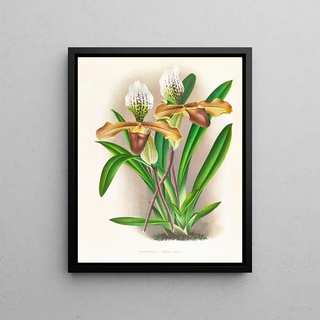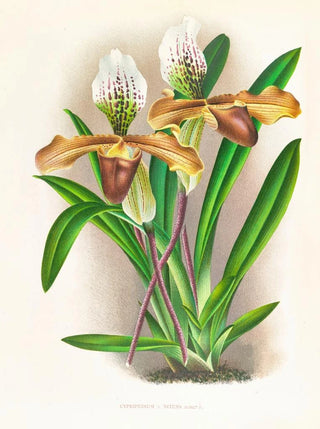Art print | Cypripedium brillant - Jean Jules Linden


View from behind

Frame (optional)
In the vast universe of floral art, the art print "Cypripedium brillant" by Jean Jules Linden stands out for its delicacy and chromatic richness. Capturing the very essence of natural beauty, this representation of the orchid Cypripedium, often called "Venus's slipper," invites the viewer to immerse themselves in a world where nature and art intertwine harmoniously. The finesse of the details and the brightness of the colors evoke a sense of lightness and serenity, while revealing the artist's passion for botany. Through this art print, Linden's spirit endures, offering a window into a universe where each petal tells a story.
Style and uniqueness of the work
Jean Jules Linden's style is characterized by meticulous attention to detail and an unparalleled mastery of painting techniques. In "Cypripedium brillant," he manages to capture not only the shape of the flower but also its essence. The delicate shades of green, pink, and white intertwine to create a composition that seems to vibrate under the effect of light. Every shadow and reflection is carefully crafted, allowing the flower to come to life on the canvas. This striking realism is the result of a deep respect for nature, but also an artistic sensitivity that transcends simple representation. Linden, a true poet of flowers, offers us a vision where natural beauty is sublimated by the artist's brush, reminding us of the fragility and magnificence of the plant world.
The artist and his influence
Jean Jules Linden, born in 1817 in Brussels, is an emblematic figure of the 19th-century botanical movement. His work is part of a tradition where art and science meet, reflecting a time when the discovery of new plant species fascinated the entire world. Linden traveled around the globe, collecting specimens and drawing inspiration from the floral diversity he encountered. His influence extends far beyond his own creations, as he also contributed to the dissemination of botanical knowledge through his publications and illustrations. By capturing the beauty of flowers with such precision, he paved the way for many artists and naturalists.

Matte finish

View from behind

Frame (optional)
In the vast universe of floral art, the art print "Cypripedium brillant" by Jean Jules Linden stands out for its delicacy and chromatic richness. Capturing the very essence of natural beauty, this representation of the orchid Cypripedium, often called "Venus's slipper," invites the viewer to immerse themselves in a world where nature and art intertwine harmoniously. The finesse of the details and the brightness of the colors evoke a sense of lightness and serenity, while revealing the artist's passion for botany. Through this art print, Linden's spirit endures, offering a window into a universe where each petal tells a story.
Style and uniqueness of the work
Jean Jules Linden's style is characterized by meticulous attention to detail and an unparalleled mastery of painting techniques. In "Cypripedium brillant," he manages to capture not only the shape of the flower but also its essence. The delicate shades of green, pink, and white intertwine to create a composition that seems to vibrate under the effect of light. Every shadow and reflection is carefully crafted, allowing the flower to come to life on the canvas. This striking realism is the result of a deep respect for nature, but also an artistic sensitivity that transcends simple representation. Linden, a true poet of flowers, offers us a vision where natural beauty is sublimated by the artist's brush, reminding us of the fragility and magnificence of the plant world.
The artist and his influence
Jean Jules Linden, born in 1817 in Brussels, is an emblematic figure of the 19th-century botanical movement. His work is part of a tradition where art and science meet, reflecting a time when the discovery of new plant species fascinated the entire world. Linden traveled around the globe, collecting specimens and drawing inspiration from the floral diversity he encountered. His influence extends far beyond his own creations, as he also contributed to the dissemination of botanical knowledge through his publications and illustrations. By capturing the beauty of flowers with such precision, he paved the way for many artists and naturalists.






